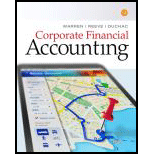
(1)
Single-step income statement format in which a single subtotal of all revenue items are listed in one column and a single subtotal of all expense items including cost of goods sold are listed in another column. Thus, the subtotal of all expense items is deducted from the subtotal of all revenue items to arrive at the net income at the bottom of the statement.
To Prepare: The income statement of Company K for the year ended June 30, 2018.
(2)
To Prepare: The
(3)
To Prepare: The
(4)
Closing entries: These refers to the
To Record: The closing entries of Company K.
Want to see the full answer?
Check out a sample textbook solution
Chapter 5 Solutions
Corporate Financial Accounting
- Can you solve this general accounting problem with appropriate steps and explanations?arrow_forwardI need help with this general accounting question using standard accounting techniques.arrow_forwardI am trying to find the accurate solution to this general accounting problem with the correct explanation.arrow_forward
- Please explain the solution to this general accounting problem with accurate explanations.arrow_forwardPlease explain the accurate process for solving this financial accounting question with proper principles.arrow_forwardJackson and Ashley Turner (both 45 years old) are married and want to contribute to a Roth IRA for Ashley. For the current year, their AGI is $236,500. Jackson and Ashley each earned half of the income. How much can Ashley contribute to her Roth IRA if they file a joint return?arrow_forward
- I am searching for a clear explanation of this financial accounting problem with valid methods.arrow_forwardJimmer has contributed $17,000 to his Roth IRA, and the balance in the account is $20,000. In the current year, Jimmer withdrew $18,800 from the Roth IRA to pay for a new car. If Jimmer's marginal ordinary income tax rate is 23 percent, what amount of tax and penalty, if any, is Jimmer required to pay on the withdrawal in each of the following alternative situations? Jimmer opened the Roth account 44 months before he withdrew the $18,800, and Jimmer is 62 years of age. What is the tax amount?arrow_forwardAlicia has been working for JMM Corporation for 32 years. Alicia participates in JMM's defined benefit plan. Under the plan, for every year of service for JMM, she is to receive 2 percent of the average salary of her three highest consecutive calendar years of compensation from JMM. She retired on January 1, 2024. Before retirement, her annual salary was $588,000, $627,000, and $666,000 for 2021, 2022, and 2023. What is the maximum benefit Alicia can receive in 2024?arrow_forward
- ABC Manufacturing Company produces widgets and has been operating for several years. The company's management team is responsible for preparing and monitoring the company's budget to ensure that it stays on track and achieves its financial objectives. ABC Manufacturing Company has recently completed its fiscal year. Management has compiled the planning budget and actual results for the year and has found that the company's actual performance fell short of its budgeted expectations. Management wants your help in gleaning extra information from what we have. The budget and actual results are as follows: Planning budget Sales revenue $5,000 Direct materials 1,000 Direct labor 1,500 Manufacturing overhead 750 Selling and administrative expenses 1,500 Profit $250 Actual results Sales revenue $4,500 Direct materials 1,200 Direct labor 1,100 Manufacturing overhead 900…arrow_forwardYou gave me unhelpful so i am also gave you unhelpful.if you will not give unhelpful then also i will not give unhelpful. what is accoun?arrow_forwardKling Company was organized in December Year 1 and began operations on January 2, Year 2. Prior to the start of operations, it incurred the following costs: Costs of hiring new employees Attorney's fees in connection with the organization of the company Improvements to leased offices prior to occupancy (10-year lease) Costs of pre-opening advertising Required: 1. What amount should the company expense in Year 1? 600 $3,000 12,000 6,000 5,000 Chapter 12 Homework assignment take frame Start-Up Costs What amount should the company expense in Year 2? +A $arrow_forward
 Survey of Accounting (Accounting I)AccountingISBN:9781305961883Author:Carl WarrenPublisher:Cengage Learning
Survey of Accounting (Accounting I)AccountingISBN:9781305961883Author:Carl WarrenPublisher:Cengage Learning College Accounting, Chapters 1-27 (New in Account...AccountingISBN:9781305666160Author:James A. Heintz, Robert W. ParryPublisher:Cengage Learning
College Accounting, Chapters 1-27 (New in Account...AccountingISBN:9781305666160Author:James A. Heintz, Robert W. ParryPublisher:Cengage Learning Managerial Accounting: The Cornerstone of Busines...AccountingISBN:9781337115773Author:Maryanne M. Mowen, Don R. Hansen, Dan L. HeitgerPublisher:Cengage Learning
Managerial Accounting: The Cornerstone of Busines...AccountingISBN:9781337115773Author:Maryanne M. Mowen, Don R. Hansen, Dan L. HeitgerPublisher:Cengage Learning College Accounting, Chapters 1-27AccountingISBN:9781337794756Author:HEINTZ, James A.Publisher:Cengage Learning,Principles of Accounting Volume 1AccountingISBN:9781947172685Author:OpenStaxPublisher:OpenStax College
College Accounting, Chapters 1-27AccountingISBN:9781337794756Author:HEINTZ, James A.Publisher:Cengage Learning,Principles of Accounting Volume 1AccountingISBN:9781947172685Author:OpenStaxPublisher:OpenStax College





